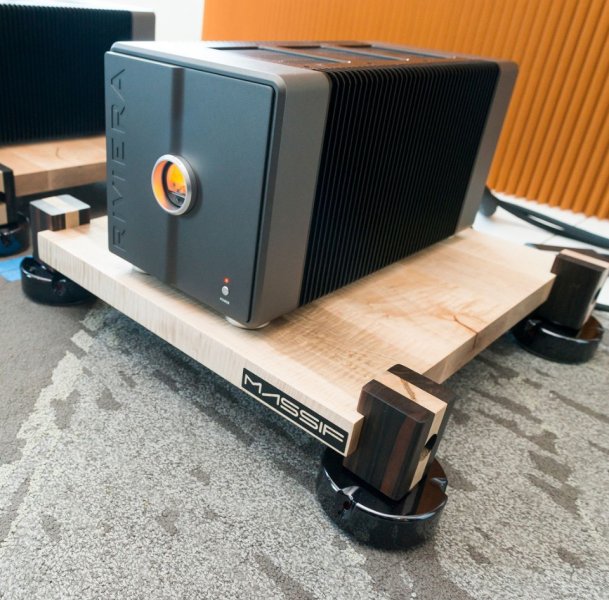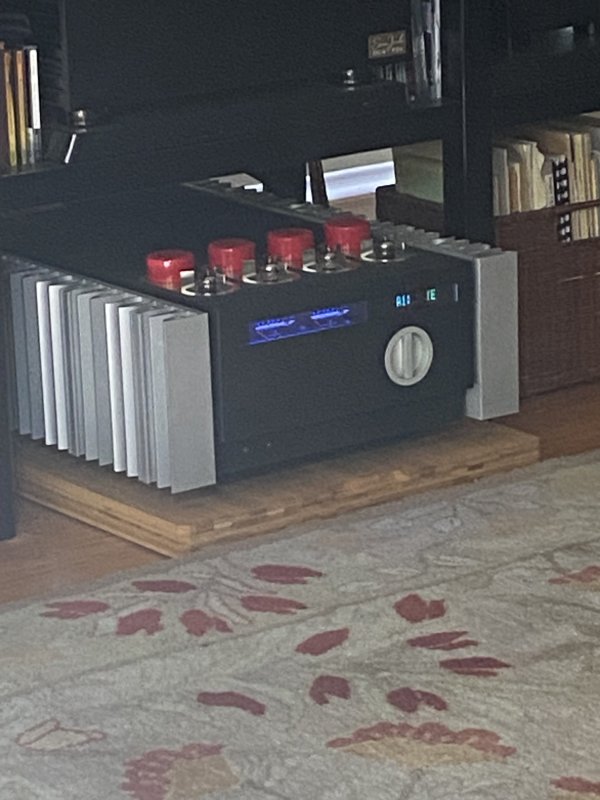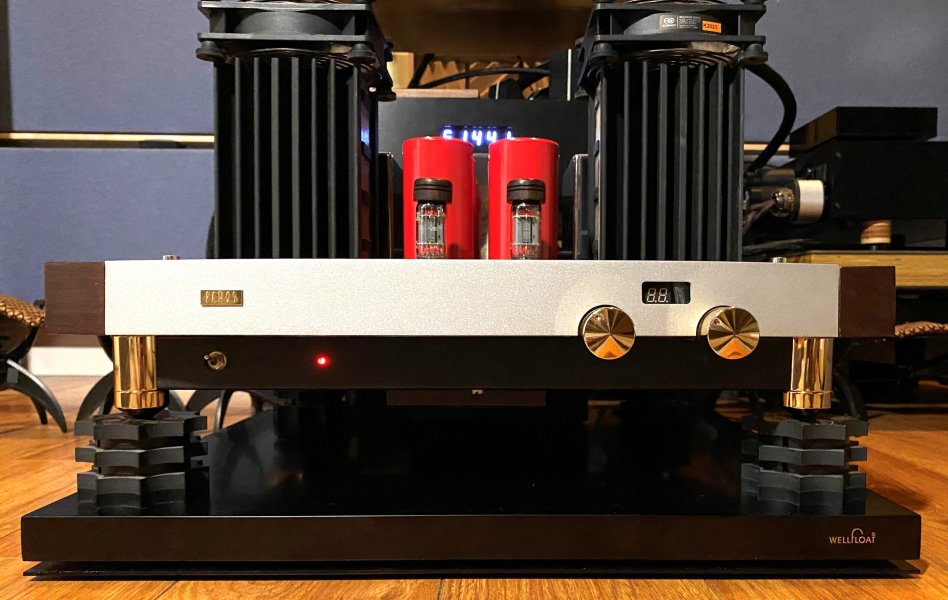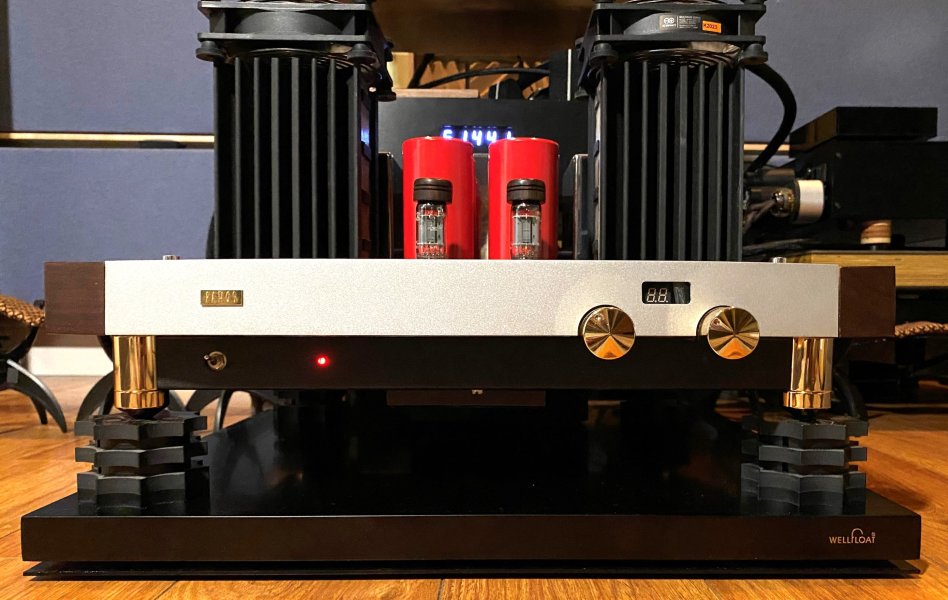That might even make the pieces a little more flat. Sounds like a pretty good idea.If you get a chance, get a pair of steel or aluminum panels built that have the same length and width as your maple platforms. The panels should be 1/2" or so to be effective. Bolt them tightly to the bottom of the maple platforms. The two dissimilar materials will rob energy from each other; the result will be considerably more dead, allowing you to play higher volumes without stress.
Amp Stand for Heavy Amp on Wood Floor?
- Thread starter Ron Resnick
- Start date
You are using an out of date browser. It may not display this or other websites correctly.
You should upgrade or use an alternative browser.
You should upgrade or use an alternative browser.
Yes.@Atmasphere, would a constrained layer material in between the two - something along the lines of what Adona does - provide any additional benefit?
 I ran these on century old wood oak floors for years, now they are on cement floors and work equally fine. With some modified footer swaps to the floor. I’ve always wondered about fancy so-called engineered CNC’d multilayered etc platforms. We’ve experimented for what it is worth with many of the presumed audiophile configurations and materials over the decades and come back to this as it simply works. Completely understanding that the aesthetic presentation often carries nearly as much weight as the sonic benefits for some but, I simply can’t fund that and would not know where to begin. I do often like the sound of laminated wood under components with little exception. These happen to be laminated bamboo repurposed cutting boards with some ISO footers and 18x24x3 granite slabs repurposed from machine tooling surface check plates. I find starting with a rock, solid footing at about 72 kg a piece (pun intended) and then floating a platform that will absorb vibration from the component without making it sound dead or hooded and isolating it from the rest of the room proves appropriate. The combination of dissimilar materials seems to do a good job of mitigating acoustic feedback from the floor (evaluated with a stethoscope) and listening to acoustic performances. I would contend that they are engineered to my ears!
I ran these on century old wood oak floors for years, now they are on cement floors and work equally fine. With some modified footer swaps to the floor. I’ve always wondered about fancy so-called engineered CNC’d multilayered etc platforms. We’ve experimented for what it is worth with many of the presumed audiophile configurations and materials over the decades and come back to this as it simply works. Completely understanding that the aesthetic presentation often carries nearly as much weight as the sonic benefits for some but, I simply can’t fund that and would not know where to begin. I do often like the sound of laminated wood under components with little exception. These happen to be laminated bamboo repurposed cutting boards with some ISO footers and 18x24x3 granite slabs repurposed from machine tooling surface check plates. I find starting with a rock, solid footing at about 72 kg a piece (pun intended) and then floating a platform that will absorb vibration from the component without making it sound dead or hooded and isolating it from the rest of the room proves appropriate. The combination of dissimilar materials seems to do a good job of mitigating acoustic feedback from the floor (evaluated with a stethoscope) and listening to acoustic performances. I would contend that they are engineered to my ears!On a cold day I put both feet above the amp.With any amp that makes heat, especially tube amps, you want about 1 foot above the amp. Otherwise consider using a fan to move heat away from the amp.
One might look a bit funny with monoblocks a ways npart and the feet up and out, but it would be a good core workout I suppose.
90 lb. Pathos TT on floor with Marigo Mystery feet (custom drilled by Marigo) and Wellfoat isolation Board:Standard Pathos footers. Herbie’s Big Fat Dots underneath bamboo plinth for ease of moving amp.
Attachments
Last edited:
I really like butcher block platforms from Butcher Block Acoustics, and I just rest them on cubical hardwood blocks onto the carpet; this provides good mechanical grounding. I then rest my component on HRS Nimbus Couplers and Spacers on top of the maple (or walnut) butcher block.
Hello Puma Cat,
What is the sonic effect of the HRS Nimbus Couplers and Spacers versus just plopping the component on the butcher block?
Improved clarity and transparency. It's an easy experiment to do; just get some and try for yourself and see what you think.Hello Puma Cat,
What is the sonic effect of the HRS Nimbus Couplers and Spacers versus just plopping the component on the butcher block?
Thank you!Improved clarity and transparency. It's an easy experiment to do; just get some and try for yourself and see what you think.
Don't doubt that the Nimbus makes an improvement. However reading what the HRS website says the Nimbus does I suspect that it is providing all of the audible improvement you are hearing since it would appear to decouple the component from the butcher block, eliminating the resonance absorption, dissipation (in the pore structure), and tuning (maple and walnut are tone woods) that is the reason for using such solid butcher block platforms/shelves in the first place. "....A very specific amount of mass, stiffness, and damping from these products eliminates chassis resonance problems and transforms residual chassis energy to heat...". Direct coupling(e.g., via brass cone) to the butcher block would transfer resonance directly into the wood where much of it would be dissipated in the pore structure and a little would feed back up through the cone, tuning the component's resonant signature to be more sympathetic to music. This is the basis for Mapleshade Audio's maple butcher block/brass cone product offerings, for example.Improved clarity and transparency. It's an easy experiment to do; just get some and try for yourself and see what you think.
if it works, which it does, then personally, I'm "good to go".Don't doubt that the Nimbus makes an improvement. However reading what the HRS website says the Nimbus does I suspect that it is providing all of the audible improvement you are hearing since it would appear to decouple the component from the butcher block, eliminating the resonance absorption, dissipation (in the pore structure), and tuning (maple and walnut are tone woods) that is the reason for using such solid butcher block platforms/shelves in the first place. "....A very specific amount of mass, stiffness, and damping from these products eliminates chassis resonance problems and transforms residual chassis energy to heat...". Direct coupling(e.g., via brass cone) to the butcher block would transfer resonance directly into the wood where much of it would be dissipated in the pore structure and a little would feed back up through the cone, tuning the component's resonant signature to be more sympathetic to music. This is the basis for Mapleshade Audio's maple butcher block/brass cone product offerings, for example.
Cheers.
No matter what we choose platform-wise, footers and all the other tweaks, everyone has their own sound and how it interacts with your gear. It's all about how the resonance of such products brings out the sonic signature of the gear or speakers. Even different spikes sound different, such as four hard apples would be placed under a preamp, for instance. It is what we like that sounds good to us, but like a TT, its arm and cartridge or mat all change the sound of the LP being played. I love LPs, but for playback, it's one of the most colored sounds there is, and a proper setup table, and of course, what it sits on. There is only absolute sound! That's the one we like best in our acoustics environment. The room is 50% of the sound we hear, so spending money on your room does not the gear merry-go-round, it's a much better payout sonically.
The quality of the recording, the room, and the gear in my opinion are each a third of the sound.
Regards
Regards
Having run an LP mastering operation for 20 years I should point out this statement really isn't true. The LP is vastly lower distortion than reel to reel tape and has wider bandwidth than tape or current digital. My Westerex 3d cutter head had bandwidth past 50KHz. The mastering amps had rolloff filters set to 42KHz to help prevent damage to the head due to the pre-emphasis of the RIAA curve (which is boosting 6dB/ocatve).I love LPs, but for playback, it's one of the most colored sounds there is
So it can have less phase shift than tape and depending on how the digital is recorded and played back, digital too.
There is in the Westerex 3D cutter system (which was the first stereo cutter system), 30dB of feedback wrapped around the cutter head and the cutter amps (which have feedback of their own). You might read Bruno Putzeys' writings (start with his article 'the F Word') about what 30dB does to distortion!
If you have colorations in LP playback, they are there mostly due to your playback system, not the LP itself. The playback (and to that end, usually the setup) is the Achilles Heel of the LP.
I am also looking for a new amp stand for my moderately heavy amp (about 40kg) on solid wood floor. One of the options I am looking at is Finite Elements Pagoda Edition. These platforms have their resonance control /decoupling technologies.
At the same tine, I already have some Ansuz Darkz T2 resonance control feet .
The question I have is if it is worth adding Finite Elements Cerabase feet (which I think primarily increase coupling with the floor) or is this overkill beyond the standard feet? Or perhaps I should do away with the Ansuz (or purchase a simpler amp platform) in order not to have competing resonance control / decoupling solutions? In other words, is it possible to have too much resonance control /decoupling going on?
Would be interested in hearing people experiences and thoughts about this matter.
Many thanks
Pedro
At the same tine, I already have some Ansuz Darkz T2 resonance control feet .
The question I have is if it is worth adding Finite Elements Cerabase feet (which I think primarily increase coupling with the floor) or is this overkill beyond the standard feet? Or perhaps I should do away with the Ansuz (or purchase a simpler amp platform) in order not to have competing resonance control / decoupling solutions? In other words, is it possible to have too much resonance control /decoupling going on?
Would be interested in hearing people experiences and thoughts about this matter.
Many thanks
Pedro
Having run an LP mastering operation for 20 years I should point out this statement really isn't true. The LP is vastly lower distortion than reel to reel tape and has wider bandwidth than tape or current digital. My Westerex 3d cutter head had bandwidth past 50KHz. The mastering amps had rolloff filters set to 42KHz to help prevent damage to the head due to the pre-emphasis of the RIAA curve (which is boosting 6dB/ocatve).
Current digital has bandwidth exceeding 85 kHz - limited by the ADCs, not the media. Both vinyl and tape can exceed tape.
So it can have less phase shift than tape and depending on how the digital is recorded and played back, digital too.
Well, you are comparing the best of vinyl with vulgar digital. A more fair comparison is SOTA to SOTA. As you suggest, nowadays the key point is how media is used, not the media itself.
There is in the Westerex 3D cutter system (which was the first stereo cutter system), 30dB of feedback wrapped around the cutter head and the cutter amps (which have feedback of their own). You might read Bruno Putzeys' writings (start with his article 'the F Word') about what 30dB does to distortion!
You should not tell such things about feedback in cutters to vinyl fans, it will decrease their listening enjoyment.
If you have colorations in LP playback, they are there mostly due to your playback system, not the LP itself. The playback (and to that end, usually the setup) is the Achilles Heel of the LP.
Well, IMO most people are in vinyl because they love these colorations, it is an hobby of preference. The same for tape colorations - people have preferred the sound coming from a tape loop to direct mic feeds.
Best results I've achieved with floor mounted amp - movement based decoupling platform (Wellfloat) with resonance draining/dissipating feet between amp and platform (custom Marigo Mystery Feet). With electronics you always need both - isolation from external vibrations and draining/dissipation of internal component resonances. Haven't encountered a device that was outstanding at both. Same approach with my source (Wellfloat platform with Dalby feet). In 50 years as an audiophile I have never encountered nor spoken with anyone who experienced too much isolation.I am also looking for a new amp stand for my moderately heavy amp (about 40kg) on solid wood floor. One of the options I am looking at is Finite Elements Pagoda Edition. These platforms have their resonance control /decoupling technologies.
At the same tine, I already have some Ansuz Darkz T2 resonance control feet .
The question I have is if it is worth adding Finite Elements Cerabase feet (which I think primarily increase coupling with the floor) or is this overkill beyond the standard feet? Or perhaps I should do away with the Ansuz (or purchase a simpler amp platform) in order not to have competing resonance control / decoupling solutions? In other words, is it possible to have too much resonance control /decoupling going on?
Would be interested in hearing people experiences and thoughts about this matter.
Many thanks
Pedro
Attachments
That was my point: the playback of vinyl. What arm, cartridge, mat, the table itself, the support it sits on, and the thickness of the vinyl being played must be accounted for with arm adjustments. Most of all, who set the table up, and how good they were. Back in the real era of vinyl, Audio Craft took an hour or more using scopes and discs to fine-tune channel separation, tracking, and distortion, and when they were done, your table was as good as it could be. Also, compression was used on cutting vinyl so the arms could track the disc. Only direct-to-disc by Sheffield Labs and a few others had unlimited dynamic range, but many arms could not track the discs. When yours was, it was high-five time. I saw the arms skip playing those discs. I love vinyl but I am strictly CD and never had a player till the late 90's when the players got better and better, much like vinyl from the 30's compared to vinyl by the 50's. By the late 70's, vinyl quality went way down; god forbid if you brought a RE LP, it sounded nowhere near my 1st pressing did, just poor sound. This is a hobby, so enjoy what you like, and that is all that counts. Any physical media is a drop in the bucket compared to streaming and downloads, which are now in the billions. I like my CDs, which I know is against the trend today.Having run an LP mastering operation for 20 years I should point out this statement really isn't true. The LP is vastly lower distortion than reel to reel tape and has wider bandwidth than tape or current digital. My Westerex 3d cutter head had bandwidth past 50KHz. The mastering amps had rolloff filters set to 42KHz to help prevent damage to the head due to the pre-emphasis of the RIAA curve (which is boosting 6dB/ocatve).
So it can have less phase shift than tape and depending on how the digital is recorded and played back, digital too.
There is in the Westerex 3D cutter system (which was the first stereo cutter system), 30dB of feedback wrapped around the cutter head and the cutter amps (which have feedback of their own). You might read Bruno Putzeys' writings (start with his article 'the F Word') about what 30dB does to distortion!
If you have colorations in LP playback, they are there mostly due to your playback system, not the LP itself. The playback (and to that end, usually the setup) is the Achilles Heel of the LP.
| Steve Williams Site Founder | Site Owner | Administrator | Ron Resnick Site Owner | Administrator | Julian (The Fixer) Website Build | Marketing Managersing |







